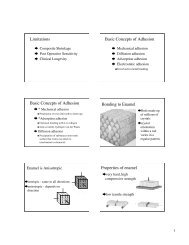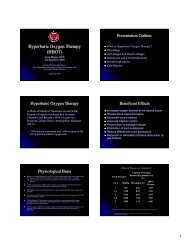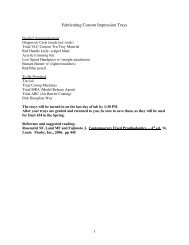Management of the deep carious lesion and the - Ohio State ...
Management of the deep carious lesion and the - Ohio State ...
Management of the deep carious lesion and the - Ohio State ...
You also want an ePaper? Increase the reach of your titles
YUMPU automatically turns print PDFs into web optimized ePapers that Google loves.
CLINICAL PRACTICE CRITICAL REVIEW<br />
Treatment <strong>of</strong> <strong>deep</strong> <strong>carious</strong> <strong>lesion</strong>s by<br />
complete excavation or partial removal<br />
A critical review<br />
Van Thompson, DDS, PhD; Ronald G. Craig, DMD, PhD; Fredrick A. Curro, DMD, PhD;<br />
William S. Green, AB; Jonathan A. Ship, DMD<br />
The treatment <strong>of</strong> <strong>deep</strong> <strong>carious</strong><br />
<strong>lesion</strong>s approaching<br />
a healthy pulp presents a<br />
significant challenge to<br />
<strong>the</strong> practitioner. The traditional<br />
management <strong>of</strong> <strong>carious</strong><br />
<strong>lesion</strong>s <strong>of</strong> any kind dictates <strong>the</strong><br />
removal <strong>of</strong> all infected <strong>and</strong> affected<br />
dentin to prevent fur<strong>the</strong>r cariogenic<br />
activity <strong>and</strong> provide a wellmineralized<br />
base <strong>of</strong> dentin for restoration.<br />
When <strong>the</strong> procedure risks<br />
exposing or even breaching <strong>the</strong><br />
pulp, however, <strong>the</strong> course <strong>of</strong> treatment<br />
becomes less predictable <strong>and</strong><br />
may require such measures as indirect<br />
pulp capping (typically using a<br />
protective material such as a calcium<br />
hydroxide–based preparation),<br />
pulpotomy or, in <strong>the</strong> most extreme<br />
cases, pulpectomy. Choosing among<br />
<strong>the</strong>se options can be daunting for<br />
<strong>the</strong> dentist—as well as for <strong>the</strong><br />
patient, who is advised <strong>of</strong> <strong>the</strong> risks<br />
<strong>and</strong> asked to share in <strong>the</strong> decision.<br />
To preclude or at least minimize<br />
<strong>the</strong> potential complications <strong>of</strong> com-<br />
ABSTRACT<br />
Background. The classical approach to treatment <strong>of</strong> <strong>deep</strong> <strong>carious</strong><br />
<strong>lesion</strong>s approaching <strong>the</strong> pulp m<strong>and</strong>ates removing all infected <strong>and</strong> affected<br />
dentin. Several studies call this approach into question.<br />
Types <strong>of</strong> Studies Reviewed. A search <strong>of</strong> five electronic databases<br />
using selected key words to identify studies relating to partial versus complete<br />
removal <strong>of</strong> <strong>carious</strong> <strong>lesion</strong>s yielded 1,059 reports, <strong>of</strong> which <strong>the</strong> authors<br />
judged 23 to be relevant. Three articles reported <strong>the</strong> results <strong>of</strong> r<strong>and</strong>omized<br />
controlled trials.<br />
Results. The results <strong>of</strong> three r<strong>and</strong>omized controlled trials, one <strong>of</strong> which<br />
followed up patients for 10 years, provide strong evidence for <strong>the</strong> advisability<br />
<strong>of</strong> leaving behind infected dentin, <strong>the</strong> removal <strong>of</strong> which would put<br />
<strong>the</strong> pulp at risk <strong>of</strong> exposure. Several additional studies have demonstrated<br />
that cariogenic bacteria, once isolated from <strong>the</strong>ir source <strong>of</strong> nutrition by a<br />
restoration <strong>of</strong> sufficient integrity, ei<strong>the</strong>r die or remain dormant <strong>and</strong> thus<br />
pose no risk to <strong>the</strong> health <strong>of</strong> <strong>the</strong> dentition.<br />
Clinical Implications. There is substantial evidence that removing<br />
all vestiges <strong>of</strong> infected dentin from <strong>lesion</strong>s approaching <strong>the</strong> pulp is not<br />
required for caries management.<br />
Key Words. Deep caries; <strong>deep</strong> <strong>carious</strong> <strong>lesion</strong>s; partial caries removal;<br />
indirect pulp capping; pulpal exposure; stepwise excavation; alternative<br />
restorative treatment.<br />
JADA 2008;139(6):705-712.<br />
Dr. Thompson is a pr<strong>of</strong>essor <strong>and</strong> <strong>the</strong> chair, Department <strong>of</strong> Biomaterials <strong>and</strong> Biomimetics, <strong>and</strong> <strong>the</strong> director, Protocol Development <strong>and</strong> Training Core, Practitioners<br />
Engaged In Applied Research <strong>and</strong> Learning (PEARL) Network, New York University College <strong>of</strong> Dentistry, New York City.<br />
Dr. Craig is an associate pr<strong>of</strong>essor, Department <strong>of</strong> Basic Sciences <strong>and</strong> Crani<strong>of</strong>acial Biology <strong>and</strong> Department <strong>of</strong> Periodontology <strong>and</strong> Implant Dentistry, <strong>and</strong> <strong>the</strong><br />
director, Information Dissemination Core, PEARL Network, New York University College <strong>of</strong> Dentistry. Address reprint requests to Dr. Craig at New York University<br />
College <strong>of</strong> Dentistry, 345 E. 24th Street/1001S, New York, N.Y. 10010-4086, e-mail “rgc1@nyu.edu”.<br />
Dr. Curro is a clinical pr<strong>of</strong>essor, Department <strong>of</strong> Oral <strong>and</strong> Maxill<strong>of</strong>acial Pathology, Radiology, <strong>and</strong> Medicine; <strong>the</strong> director <strong>of</strong> pharmaco<strong>the</strong>rapeutic research,<br />
Bluestone Center for Clinical Research; <strong>and</strong> <strong>the</strong> director, Recruitment, Retention, <strong>and</strong> Operations Core, PEARL Network, New York University College <strong>of</strong> Dentistry,<br />
New York City.<br />
Mr. Green is a scientific writer, PEARL Network, New York University College <strong>of</strong> Dentistry, New York City.<br />
The late Dr. Ship was a pr<strong>of</strong>essor, Department <strong>of</strong> Oral <strong>and</strong> Maxill<strong>of</strong>acial Pathology, Radiology <strong>and</strong> Medicine, New York University College <strong>of</strong> Dentistry; a pr<strong>of</strong>essor<br />
<strong>of</strong> medicine, New York University School <strong>of</strong> Medicine; <strong>and</strong> <strong>the</strong> director, PEARL Network, New York University College <strong>of</strong> Dentistry, New York City.<br />
JADA, Vol. 139 http://jada.ada.org June 2008 705<br />
Copyright © 2008 American Dental Association. All rights reserved.<br />
Downloaded from<br />
jada.ada.org<br />
on October 20, 2008






